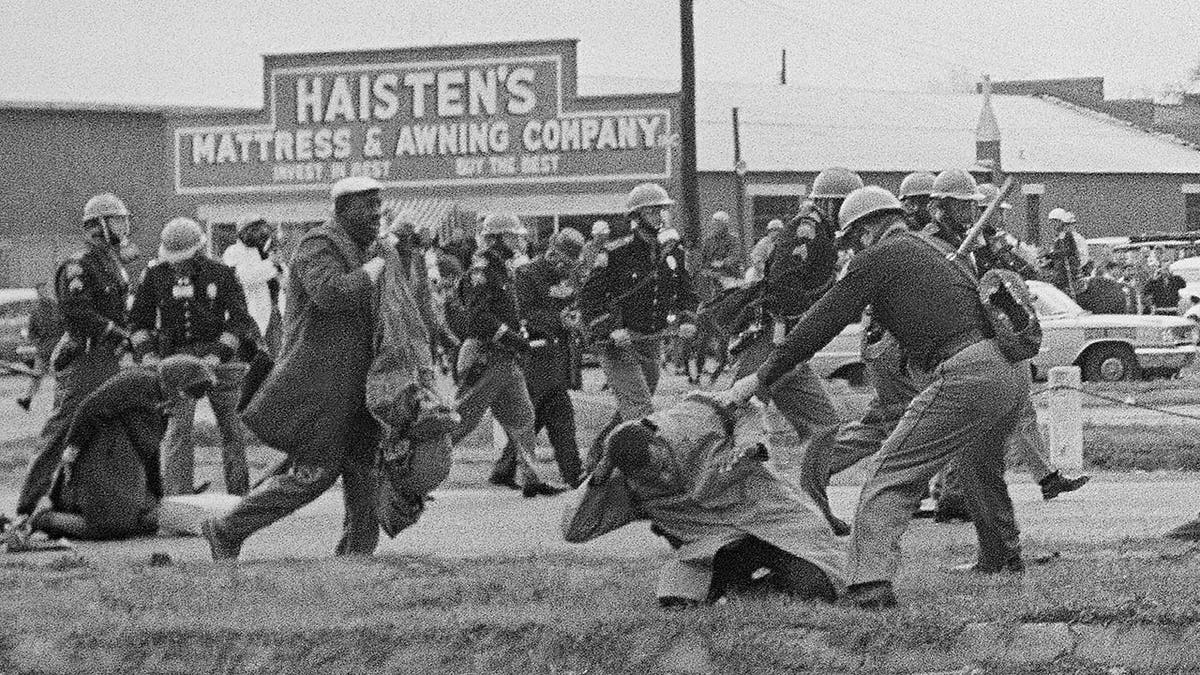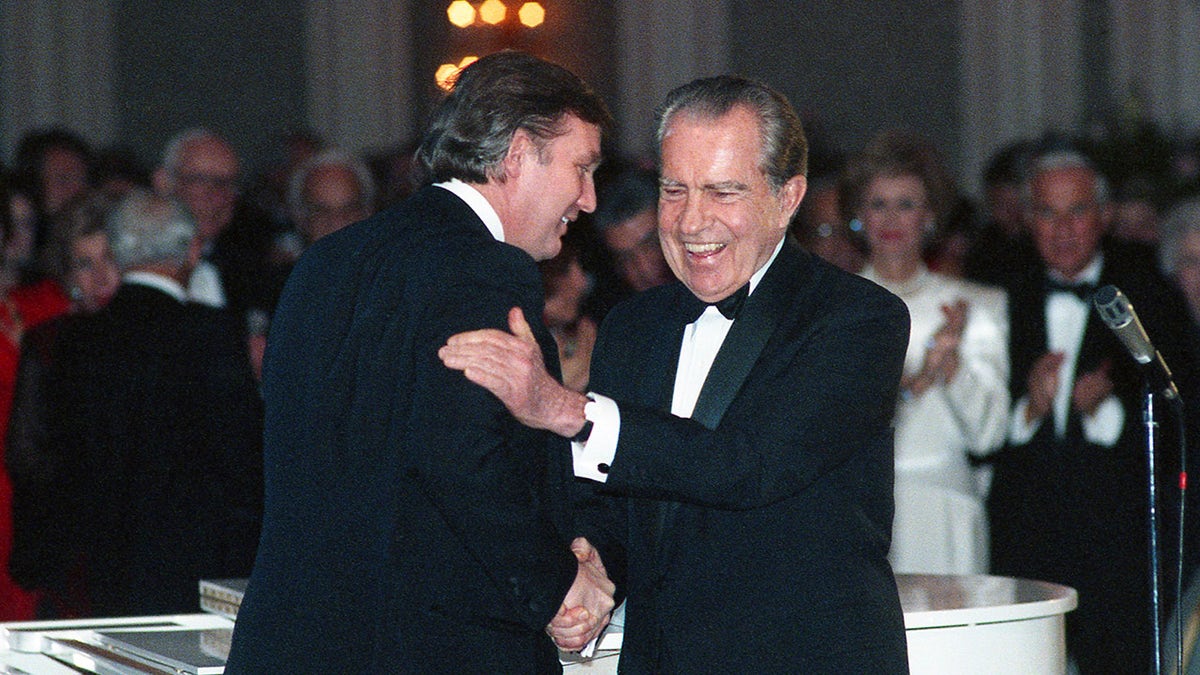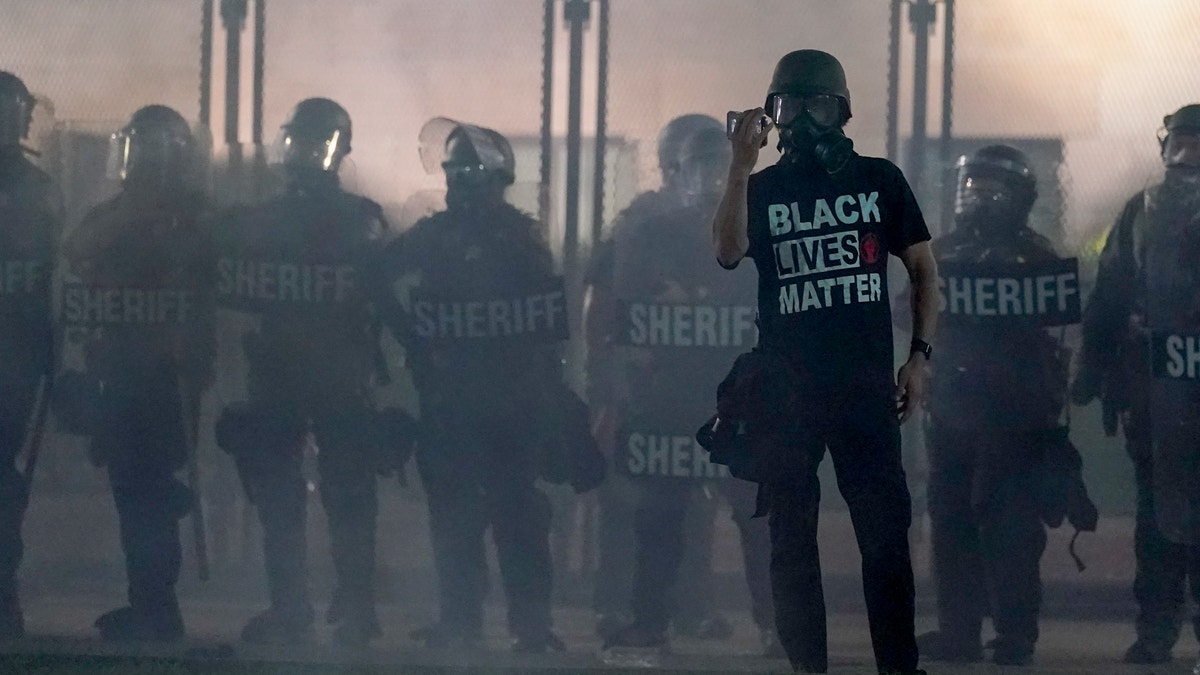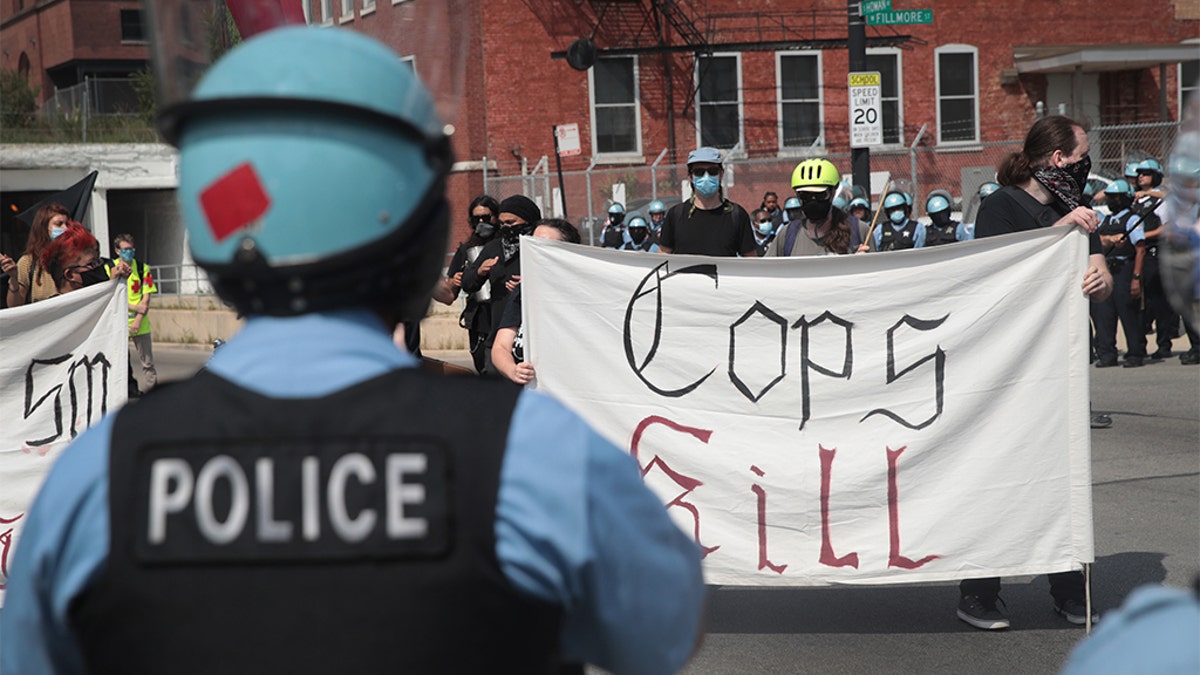The protests that took place across the country between May and August, as well as a new surge in violent crime in several U.S. cities, could impact voter decisions come Nov. 3, according to experts.
The question is whether that impact will be great enough to sway undecided voters toward President Trump's message of law and order or Democratic nominee Joe Biden's combined message of order and equality.
"People were in fear while it was happening and they're still afraid something is going to flare up," Erin Decker, Kenosha County GOP chair, told Fox News of the general feeling among voters in Kenosha after riots took hold of the city between Aug. 23 and Aug. 25 after the officer-involved shooting of Jacob Blake.

This Aug. 28, 2020 aerial photo shows damage to businesses in Kenosha, Wis. Police in Kenosha have arrested dozens of people since a white officer shot Jacob Blake in the back. (Sean Krajacic/The Kenosha News via AP)
She added that residents "were very happy that President Trump stepped up" and sent federal assistance to Kenosha, which voted narrowly for Trump in 2016 by a .33% margin after the governor refused his help.
Trump's law-and-order message
The civil rights protests that took place ahead of the 1968 U.S. presidential election played a hand in the election of former Republican President Richard Nixon, who campaigned on a "law and order" message that later Republican presidents including Trump and the late Ronald Reagen adopted for their own messaging.
But the 1960s protests also sparked an increase in the White Democratic vote at the time, according to Omar Wasow, assistant professor of politics at Princeton University and author of the May research paper "Agenda Seeding: How 1960s Black Protests Moved Elites, Public Opinion and Voting."
The protests that took place across major U.S. cities this summer are similar to the 1960s protests in that "incidents where there is unjust use of force continues to spark protests in the United States," Wasow told Fox News.

A state trooper swings a billy club at John Lewis, right foreground, chairman of the Student Nonviolent Coordinating Committee, to break up a civil rights voting march in Selma, Ala. (AP Photo/File)
They are also similar because of the connection between protests and violence, as well as Trump's 'law and order' messaging tactic. Whereas Nixon's law-and-order rhetoric was balanced with civil rights language, however, the president's rhetoric focuses mainly on stopping violence with the help of law enforcement," the professor continued.
"Nixon was very strategic about co-opting the language of rights in his advocacy of law and order," Wasow added.
One such example comes from a speech Nixon gave during his 1968 campaign.
"Crimes of violence in the United States have almost doubled in recent years. Today, a violent crime is committed every 60 seconds. A robbery every two-and-a-half minutes. A mugging every six minutes. A murder every 43 minutes," he explained. "… And it will get worse unless we take the offensive. Freedom from fear is a basic right of every American. We must restore it."
This kind of message, balancing basic rights with law and order, differs from Trump's message, which "really looks much more like the way in which people perceived George Wallace in the 1960s. ... It's not a path to a majority," Wasow said.

In this March 11, 1989, photo Donald Trump shakes hands with former President Richard Nixon at a tribute gala to Nellie Connally at the Westin Galleria ballroom in Houston, Texas. (Richard Carson/Houston Chronicle via AP)
He continued: "We've got the pandemic, the economy in recession, and even if you want order or some better balance of rights and order... it's not clear Trump has made a credible case for himself as the kind of stable provider of law and order that people might want."
On the other hand, a number of police unions and other law enforcement agencies and organizations have endorsed Trump ahead of the election.
"He has both...right-of-center voters, people who care about gun rights [and] people who are aligned with police unions," Wasow said. "... But that does not appear to be a majority of Americans in public opinion polls."
The media
Today's protests and the 1960s protests are different in another way: advancements in media coverage, Wasow said.
"In the 1960s, for any incidents of violence — whether it was by protesters or the state — to reach the mass public, there had to be mass media there to document it, but now because everyone has a camera in their pocket, everything from the initial incident of [Minneapolis] Officer [Derek] Chauvin resting his bodyweight on George Floyd's neck to, later, protests and countermobilization by police ... all of that is being documented by citizens," Wasow said.
He added that the rapid documentation of these video images has "a powerful way of changing people's understanding of what's happening," and he thinks that "the public, on the whole, has been sympathetic to the concerns of protesters" who are nonviolent.

A protester holds up a phone as he stands in front of authorities in Kenosha, Wis. (AP Photo/Morry Gash, File)
The media's portrayal of isolated incidents of violence caught on camera, and often without a great deal of context, matters in swaying the public opinion, as well,
On the third day of protests in Wisconsin, 17-year-old Kyle Rittenhouse allegedly shot three people and has since been charged with first-degree intentional homicide, attempted first-degree intentional homicide and other crimes, according to Kenosha News.
In a video interview with the Daily Caller recorded two hours before he shot his first victim, Rittenhouse says it is his "job to protect businesses" and "help people," adding that his reason for holding a rifle during protests was to protect himself.
A New York Times investigation analyzed video clips from the night showing Rittenhouse in action and laid out a timeline of events. Rittenhouse's attorneys are arguing that the 17-year-old was acting in self-defense during the night of the protests.

Kyle Rittenhouse, left, with backwards cap, walks along Sheridan Road in Kenosha, Wis., with another armed civilian. (Adam Rogan/The Journal Times via AP, File)
Journalists and pundits across the political spectrum were quick to point out their respective analyses of the footage showing Rittenhouse, questioning whether he was really acting in self-defense, justifying his actions or making other judgments about his character.
Trump supporters like Decker say "the majority of people do not believe" charges against Rittenhouse "are accurate" and gave her own account of a Kenosha resident she knew who was helping guard businesses and put out fires during the riots.
"Private citizens said they weren't going to take it anymore, and people came [to the protests] with their friends with fire extinguishers, and because of that ... there was less burning," she said.
Spikes in violent crime
The Kenosha County GOP chair thinks people across the country have seen Trump demonstrate leadership where governors and mayors have not during riots.
"They know that Trump is taking these riots and destruction seriously, and he wants to help cities like Portland that still have rioting going on...while local elected officials are refusing Trump's help," Decker said. "...The enthusiasm is definitely behind Trump, which was evident when he came to town right after the riots."
The protests and riots that began in May were largely backed by the phrase "defund the police," which gained quick momentum among progressives, who argue that police funding should be allocated toward other community services to end violence, after Floyd's death. But conservatives say defunding police departments would lead to more crime.

Police survey an area after a police officer was shot, Wednesday, Sept. 23, 2020, in Louisville, Ky. (AP Photo/John Minchillo)
Biden has said he does not support defunding the police.
A number of major U.S. cities have already seen spikes in crime due to reassignments and increasing retirement numbers, despite reduced police budgets not having gone into effect yet.
Chicago, New York City, Philadelphia, Milwaukee and Detroit have seen spikes in homicides, aggravated assault and gun assaults this year, according to July and September research from the nonpartisan National Commission on COVID-19 and Criminal Justice (NCCCJ).
At the same time property and drug offenses in 2020 fell, in part due to lockdowns, commercial burglary spiked 200% across 27 cities during a single week in May. The homicide rate "increased significantly" through the end of June — led by Chicago, Philadelphia and Milwaukee — and spiked 53% between June and August over the same period in 2019, researchers found.
The New York Police Department (NYPD) released data last week showing a 127% increase in shooting incidents year-over-year and a 40% increase in murders year-over-year.
Aggravated assault grew 35% between late May and the end of June and 14% between June and August with Louisville, Nashville and Detroit at the top of the list, according to the NCCCJ. Seventeen cities recorded a spike in gun assaults at the end of May led by Chicago.

Police stand guard as pro and anti-police demonstrators gather outside of the Homan Square police station on August 15, 2020 in Chicago, Illinois. (Photo by Scott Olson/Getty Images)
"The question becomes, why did murders and shootings go up? And I think the clear answer is: that's when the anti-police protests began around the country, and there were two things that happened. One was that police had to be redeployed to manage protests," said Paul Cassell, a professor at S.J. Quinney College of Law at the University of Utah.
Second, "the police [who] were redeployed were working on what might be called discretionary police activities," or "proactive policing," and "when they were pulled away from those discretionary activities, that meant potential shooters were aware that police patrols were down, and they began carrying more firearms, and...more shootings and homicides resulted."
Cassell has dubbed the spike in crime in cities across the U.S. "the Minneapolis effect," which he explains in a Sept. 10 research paper titled "Explaining the Recent Homicide Spikes in U.S. Cities: The 'Minneapolis Effect' and the Decline in Proactive Policing."
Both Cassell and Wasow agreed that it is too early to conclude that the "defund the police" movement will lead to continuing spikes in crime since most of the crime surges the country has seen so far happened over the summer before police department funding was slashed.
Cassell argues, however, that recent crime spikes could be "projecting what would happen into the fall or next year if 'defunding the police' is taken to its logical conclusion."

Temporary election worker Joseph Banar disinfects voting stations as a precaution against the coronavirus...on Tuesday, Oct. 6, 2020, in Santa Fe. (AP Photo/Morgan Lee)
"Defunding the police means, at some level, cutting back on law enforcement activities," he said. "... So I think we can project, just as the police have had to pull back this summer due to the protests, if they have to pull back due to defunding, we can expect high levels are particularly homicides or shootings to persist and maybe even increase further."
What it all means to voters
Wasow said America is even more polarized than it was before Nixon was elected, and most people cannot be swayed at this point in the election season.
"Even if violent protesters are swaying voters," it will not be "enough to be pivotal," he said.
He and Cassell agreed that crime is becoming an increasingly important issue for voters, but it is most salient to ubran voters. How candidates address increases in crime will matter come Nov. 3.
"It's taken us a couple months to realize the magnitude of what's happening," Cassell said. "As I said, the latest data through the end of August is a staggering 50% increasing in homicides, mostly concentrated within the last couple of months."
He added that there "hasn't been enough attention paid to" the increase in violent crime "as would be appropriate."
"These are truly staggering increases, the likes of which we haven't seen in years, and these crimes are extremely serious ... so I would think it deserves a lot more attention than it has been receiving," Cassell said.





